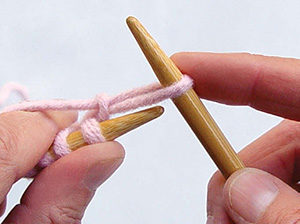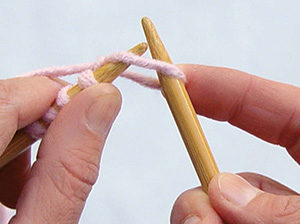Cast on to create the foundation stitches of knitting. Most knitters start each project the same way they were taught when they learned to knit. But there is a whole world of other options out there to explore. Becoming familiar with them and their characteristics enables the knitter to make appropriate choices when a pattern itself gives little or no guidance.
The Knitted Cast-On
Let’s start with the knitted-on cast on. It is very basic, is worked with two needles and is almost the same as knitting. Unlike some others, it allows you to easily add stitches onto a row of existing stitches. Begin by putting a slip knot on your left-hand needle. Insert the right needle into the slip knot as if to knit, wrapping the working yarn around the right needle as when knitting and pulling through a new loop, but don’t take the old one off the left needle. Instead, move the left needle below (to the right of) the new loop on the right needle; now put the new loop back on the left needle (see Photos 1 and 2). Putting the new loop back on the left needle in this fashion will make a nice edge. Continue in this fashion, working into the last loop made, until you have the desired number of stitches on your lefthand needle.
Picot the Night Away
To add a pretty picot edge to your work, cast on extra stitches and then immediately bind them off. For example, cast on three stitches, bind off one stitch, put the single stitch now on the righthand needle back on the left-hand needle and repeat. The bound-off stitches create the decorative bumps, or picots, along the edge of the work. The size of the picots can be varied by changing the number of stitches that are cast on and bound off. The number of stitches between picots can also be varied for different effects.
To work the another type of picot edge, begin by making a slip knot and using the knitted-on cast-on to add three stitches. Bind off one stitch as usual by knitting two and pulling the first stitch over the second. Place the single stitch on the right-hand needle back on the left needle as when working the knitted-on cast-on, by taking the left needle below (to the right of) the stitch to transfer it. From this stitch, cast on three stitches using the knitted-on cast-on, bind off one, put one back, repeat. For every three stitches, one is bound off into a picot; picot stitches are separated by one plain cast-on stitch.
If you hadn’t used them before, now you have two more cast-ons in your knitting toolbox, one utilitarian and one decorative. The knitted-on cast-on can add back stitches that were bound off for buttonholes, and the picot cast on adds a cute edging to socks or baby clothes. Grab some yarn and start stitching!









2 Responses to Cast On Options — Knitted-On & Picots By Beth Whiteside